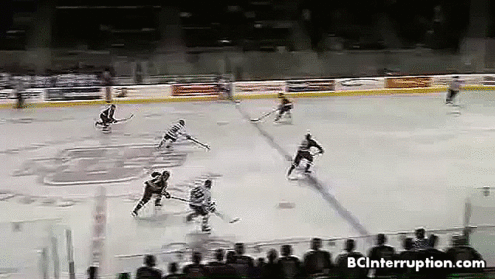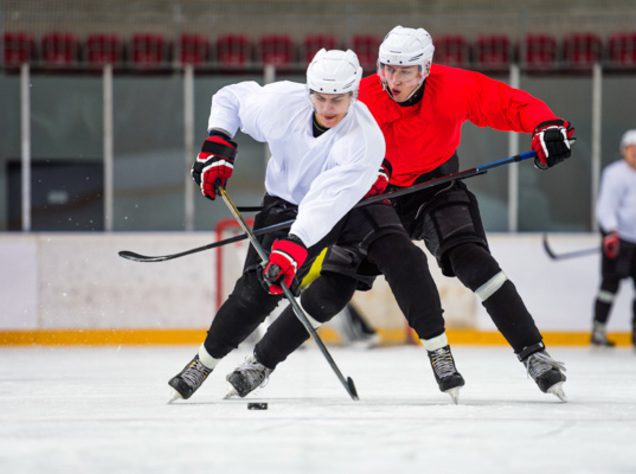Understanding Icing + Offsides
As if learning how to skate wasn’t hard enough, now you’ve got to learn the intricate rules of hockey as well? It might seem intimidating at first for any beginner hockey player, but the more you play and practice, the less you’ll even think about it. CoachUp has compiled a list of tips to remember for anybody who is a bit hazy on the rules. If anything, just remember that the red and blue lines are your best friends!
For the purpose of these two rules, focus on those lines going across the ice. The red line that divides the ice into two sides is known as the center line. In each half, there is a blue line and a smaller red goal line. After our quick review, you’ll never forget the rules again!
Icing
Icing occurs when a player shoots the puck from his defensive half of the ice and it goes over the red goal line at the opposite end without anyone touching it. Or, in simpler terms, there’s icing when a player passes it from red line to red line without it being touched. This stops frantically defending teams from playing the puck out of their zone without direction or finesse. In hockey, defending teams cannot just desperately clear the puck and be rewarded. If this happens, play is stopped an official and the game is reset via face off in the defensive zone of the team that iced the puck.
Example: If the Ducks dump the puck out of their zone and it passes both red lines without being touched, play stops and restarts back in the Ducks’ zone inside the blue line.
Got it? However, there are a few instances in which icing is not called despite this criteria being met. They are as follows:
- If the team dumping the puck is currently killing a penalty, then there will be no icing called.
Example: If the Ducks are short-handed and playing 4-on-5, they’re allowed to relieve pressure by playing the puck to the other side of the ice without a stoppage in play.
- If it goes in the net or the opposing goaltender is forced to play it.
Example: The Ducks have pulled their goalie and are playing 6-on-5 against the Hawks. Despite the extra pressure and man, the Hawks are able to clear the puck out of the zone and down the ice. Without the Ducks’ goalie in net, the puck goes in. This is a fair goal for the Hawks, despite the puck crossing both red lines.
Additionally, if the puck is cleared down ice but straight at the opposing goalie, forcing him to touch the puck, it is not icing and play continues.
- If an opposing player touches the puck at any point, whether intentional or not, then the icing is voided.
Example: The Ducks dump the puck down the ice, but as it travels, it deflects off a player on the Hawks. From there, it travels past the second red line, but it’s waved off for having made contact with an opponent.

Offside
Offside occurs if a player crosses the blue line while attacking before the puck does. This stops players from cherry picking up ice or giving attacking teams an unfair advantage. If you’re familiar with the offside call in soccer — in which a player must be in front of the last defender before being played the ball — then imagine the blue line in hockey as a solid, never-moving last defender akin to soccer.
Examples: If the Ducks are advancing as an attacking unit and Player A has the puck, but Player B crosses the blue line before Player A does, offside is called. Similarly, if the puck clears the offensive zone but the offensive team keeps possession, all attacking players must cross the blue line back towards center ice before being allowed to touch the puck again. If the puck re-enters the offensive zone and any player has not retreated back to the blue line, offside will be called.
If the Ducks are advancing as an attacking unit and Player A, B, C, D, and E are all past the blue line in their offensive zone and attacking the opposing goalie. The Hawks are able to clear the puck out to center ice, but Player D recovers the puck for the Ducks. Player A, B, C, and E must skate back into the neutral zone and wait for the puck to legally cross the blue line once again. Furthermore, take that same situation and Player A, C, and E all leave the offensive zone, but Player B cannot before the puck crosses the blue line, the play is dead and offside is called.
Additionally, you must be weary of the two-line pass. This result happens when a player passes the puck from behind the blue line in his defensive zone to one of his teammates who is behind the red line at center ice. This, again, helps to stop teams from getting an unfair attacking advantage. This is one is easy to remember! If the pass crosses two lines before being received, then it’s offside. For example: Player A has the puck behind his own blue line and passes it to Player C who is past the red line at center line, he is offside. When Player A passed the puck, it crossed the blue line and then the red line before reaching Player C.

In the gif above, check out the awesome freeze frame as the puck is crossing the blue line into the offensive zone. Both the left wing and right wing are considerably offside and play should’ve been stopped. However, the referee missed the call and it ultimately allows #22 to score a goal that never should’ve happened.
(Related: Read about dryland stickhandling here.)
Huddle Up
Overwhelmed? That’s perfectly normal, especially for new hockey players. In fact, even the most experienced and knowledgeable of athletes get these rules incorrect from time to time, so don’t worry. The written concepts of the icing and offside rules in hockey are confusing to read, but once you get out on the ice and experience it yourself, things will become far more clear.
CoachUp has plenty of private trainers that are willing to help you walk through these rules and more in person. For athletes that are just starting to learn hockey, a private trainer could give you a huge leg up over the competition. What are you waiting for?
How useful was this post?
Click on a star to rate it!
Average rating 4.7 / 5. Vote count: 34
No votes so far! Be the first to rate this post.





2 Responses
Thank you so much! Was getting a bit confused with different icing situations and this truly helped!
Yes I finally understand Icing for someone born in 1975 an expert on Football since I was 9 yearsold Basketball since I was 13 Baseball since I was 9 I finally understand that
“Icing
Icing occurs when a player shoots the puck from his defensive half of the ice and it goes over the red goal line at the opposite end without anyone touching it. Or, in simpler terms, there’s icing when a player passes it from red line to red line without it being touched. This stops frantically defending teams from playing the puck out of their zone without direction or finesse. In hockey, defending teams cannot just desperately clear the puck and be rewarded. If this happens, play is stopped an official and the game is reset via face off in the defensive zone of the team that iced the puck.
Example: If the Ducks dump the puck out of their zone and it passes both red lines without being touched, play stops and restarts back in the Ducks’ zone inside the blue line.
Got it? However, there are a few instances in which icing is not called despite this criteria being met. They are as follows:
If the team dumping the puck is currently killing a penalty, then there will be no icing called.”
So the team on Defense can’t just take the Puck and hit it with the stick and make it go all the way to the otherside of the Ice just so the opposing team isn’t near their goal it can’t pass over Redline and Redline without anyone touching so the Basketball player who throws the Ball with 8 seconds to go to the otherside of the court where no one is so it will end up out of bounds estimate 3 seconds with 5 seconds left in the game so the other team has to inbound and try and score a Hockey version of that would be the Puck all the way on the otherside with no opposing players other then the goalie so the opposing team on Offense has to go to their Defensive side to get the Puck can’t do it